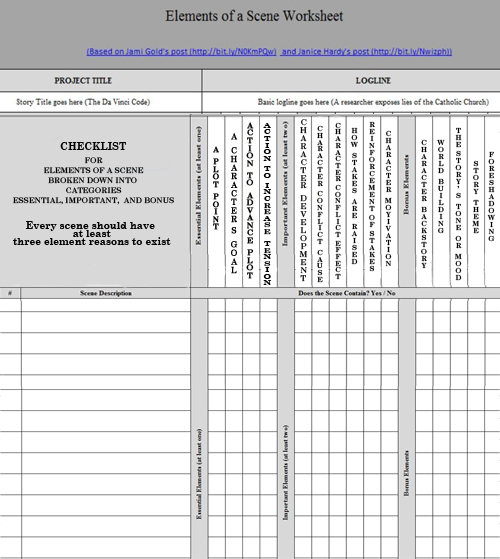 Yvonne Ventresca (Pandemic author) sent me a note pointing out all the wonderful writing worksheets on Jami Gold’s Blog. I wanted to make sure I pointed out all the helpful information you can find, download, and use on her site.
Yvonne Ventresca (Pandemic author) sent me a note pointing out all the wonderful writing worksheets on Jami Gold’s Blog. I wanted to make sure I pointed out all the helpful information you can find, download, and use on her site.
Last week we talked about the Seven Point Story Structure System. You can find worksheets for other story structure systems to use on Jami’s site, too.
I particularly like the one below because you can use to see if each scene in your manuscript has what it takes when you revise.
Here is Jami Gold’s Elements of a Good Scene Worksheet from her blog:

Use this link to download and print the spreadsheet out to use: http://jamigold.com/for-writers/worksheets-for-writers/ – Check it out!
Jami also does workshops:
Full Beat Sheet Basics OnDemand Workshop Information:
Beat sheets, long used by movie scriptwriters, can also help us create strong stories for our novels.
Don’t know what beat sheets are or how to use them?
Do you write by the seat of your pants and don’t want to plan your story in advance?
Never fear—learn the terminology, uses, and ways to adapt beat sheets to our writing methods. At the end of this class, students will have an overview of story structure and beat sheets:
- Introduction to story arcs
- Introduction to beats and terminology
- Digging deeper to avoid formulaic clichés
- Using beat sheets to find unnecessary scenes and pacing issues
- How those who write by the seat of their pants can use beat sheets too
Click here for more information about Jami Gold’s Beat Sheet Basics OnDemand Workshop
A little bit about Jami: After escaping the corporate asylum by leaving a clone in her place, Jami Gold moved to Arizona and decided to become a writer, where she could put her talent for making up stuff to good use. Fortunately, her muse, an arrogant male who delights in causing her to sound as insane as possible, rewards her with unique and rich story ideas. Fueled by chocolate, she writes paranormal romance and urban fantasy tales that range from dark to humorous, but one thing remains the same: Normal need not apply. Just ask her family—and zombie cat.
Thank you Jami for sharing this with all of us.
Talk tomorrow,
Kathy
Filed under:
Advice,
Courses,
How to,
opportunity,
reference,
writing Tagged:
Downloadable Writing Worksheets,
Forms,
Jami Gold,
Yvonne Ventresca 


metrical tree of an iambic foot (Photo credit: Wikipedia)
One of the misconceptions about poetry is that you have to spend years studying it, learning every nuance about it, have an MFA degree in it, ad infinitum before writing your first poem of consequence. I’m sure some teacher somewhere planted that propaganda early, during the organization of educational systems, to terrorize the average student into the closet, never to pen verse again.
Odd as it may seem, verse began long before written language. When you find an ancient Viking, ask him. He can probably recite one of the sagas and leave you breathless for a couple of hours.
What is it about poetry that demands that it be written down in certain forms to be considered legitimate?
Consider this case: unless one is a serious scholar of poetic form, the truth about the small and unobtrusive haiku, with its few words and syllables, would never surface in this country. True Japanese Haiku has no title (Americans seem to find one necessary for meaning.) It uses 17 morae, which are not syllables.
For those who are really interested in a complete explanation of the difference between morae and syllables, Marc van Oostendorp published a marvelous paper on Mora Theory in 2005. Suffice it to say that individual languages, such as Japanese, are high in moraic qualities. Entire analysis formulas exist to document a language’s spoken moraic structure.
American English isn’t an especially moraic language. And there are probably few poets in this country that would rather do pure Haiku than use syllables and deviate. When I have at least a few months to devote to additional study, I’ll delve into this precision of thought. Until then, I’ll muddle through with the American version.
Here’s a simple haiku as an example.
Water rushing now,
Stones weeping my memories
Time flows without end.
This verse, that I wrote many years ago, exhibits the common 5-7-5 syllable line scheme. The trick to Haiku, I’m told, is the juxtaposition of its subject elements.
Here I begin with rushing water, placing it i

Haiku (Photo credit: lux2night)
Seasons come and seasons go: isn’t that the old song? Today’s writing prompt for the month centers on Seasons. Choose a season, use that for your title, write a poem about it; that was the prompt.
I can do that. That’s a simple fix for my poetry habit. Haiku is the answer for days when time is running in short supply. I admit, though, that at least one of these is a bit irreverent. Can you pick out the one(s)?
Winter
Popcorn ball flakes sail,
With winds howling for fear’s sake,
Drifting to bring peace.
Spring
Seeds’ green heads waver,
Nodding to sky in joy,
Leaving Dark for Light.
Summer
Daisies keep cow friends
Company on sunshine days,
Giving selves as food.
Fall
Squirrels hurry on,
Gathering winter’s food choice,
Quarrel over safes.
I may take another crack at it late this afternoon, so stay tuned for developing events. Take care, all. Enjoy yourselves. Tell your friends to stop by. They’re not obligated to sign a contract or anything. TTFN
© Claudette J. Young 2012



 4 Comments on Running Around the Calendar, last added: 4/12/2012
4 Comments on Running Around the Calendar, last added: 4/12/2012
 Yvonne Ventresca (Pandemic author) sent me a note pointing out all the wonderful writing worksheets on Jami Gold’s Blog. I wanted to make sure I pointed out all the helpful information you can find, download, and use on her site.
Yvonne Ventresca (Pandemic author) sent me a note pointing out all the wonderful writing worksheets on Jami Gold’s Blog. I wanted to make sure I pointed out all the helpful information you can find, download, and use on her site.







What a great post…and just in time for my revision. I’m having some trouble with scene content, and will use Jamie’s guides to help things along. Thanks Kathy and Jamie!
Wow, thanks! These are great for us plotter-people.
Donna,
I thought so, too. I’m going to try them out as soon as I get the Christmas decorating done.
Happy holidays,
Kathy
Darlene,
That’s the first one I am going to use.
See you soon,
Kathy
Yes, Jami’s blog is chock full of writing goodies. Glad to see her on your blog, Kathy. :-)
Ooooooh, Kathy, you KNOW how I love charts! lol This one is great only I know I’d have to redo it so that the column headings didn’t read top to bottom! Love this! Thank you :D
Thanks for this post, Kathy. Jami’s blog is a gold mine of ideas and solutions. Love it!
Donna,
You don’t have to do that. Jami already has it that way. I changed it so people could read it on the blog. It was too small to read when I reduced it.
Tracy,
I’m glad I found her to put her up. I am sure her worksheets will help a lot of writers.
Talk soon,
Kathy
Glad you found the link useful!